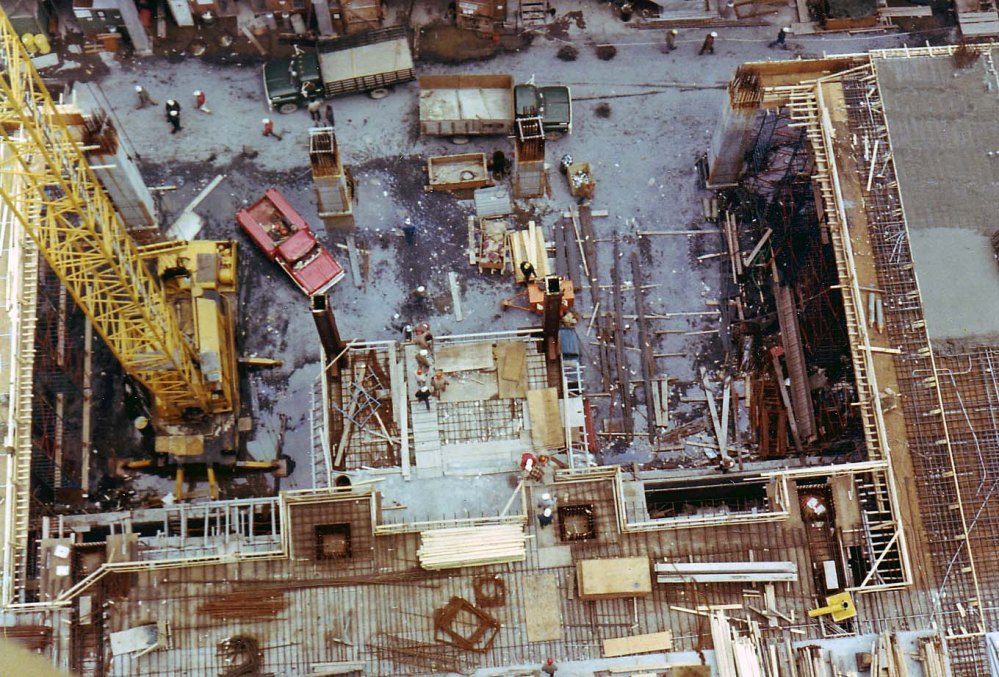Our thanks to Gerry and Mary Dwileski for their help with this post.
When we reached out to South Mall construction workers last year, we were surprised that the first response came from Mary Dwileski, the wife of a carpenter. Since then, we have conducted oral histories with many men who worked construction at the South Mall and have come to realize that this first contact was not so strange. While demolition of the 98 acres devastated thousands of family homes, its redevelopment helped young couples, like the Dwileskis, get their start. For many local men and their families, construction of the Empire State Plaza meant the acquisition of marketable skills and a high-paying job.

When Gerry Dwileski graduated from high school in 1967, he found few employment options. He applied for a job at the power company, but there was a two-year waitlist. At the time, Gerry’s father, Tony, was working as a pile driver at the South Mall site, and three of his brothers also had South Mall construction jobs. With his father’s help, Gerry soon found work on Agency Building #2. As an apprentice carpenter, Gerry carried a lot of coffee to the more senior carpenters, but at $2.50/hour, he took home more pay than his future father-in-law, John Kutryb, a longtime employee at General Aniline in Rensselaer.
Gerry and Mary began dating soon after he started work on the South Mall. The salutatorian and newspaper editor of St. Joseph’s Academy class of 1968, Mary Kutryb was attending Maria College on full scholarship, while living at home. Her family’s house on Orange Street, between Hawk and Swan, was only a few blocks north of the South Mall construction site.

In his black Ford Falcon, Gerry drove Mary all around the area—to Thacher Park and the aerodrome in Duanesville. He even taught her to ski. They talked about their hopes for the future—including a plan to build a house of their own.

In 1971, after Gerry returned from 20 months active duty in the Navy Reserves, the couple married. Mary found a job as a secretary for a local law firm, while Gerry went back to the South Mall. Veterans preferences assured that a job would be waiting, and anyway, he says, “they were begging for guys then.” And Gerry was already well-known and well-liked by his peers.
Gerry worked for South Mall Constructors, the joint venture that in 1971 was still in the early stages of building the Cultural Education Center. He did primarily formwork, the carpentry required for pouring concrete. Each day, he would climb up the scaffold steps and remain there until his shift was over. The 30-minute lunch hour slipped by so quickly that he and his fellow workers seldom made it down to the ground. Instead, they would heat up a bucket of Kentucky Fried Chicken with a torch on a foil covered H-beam.

Gerry was usually home by 4pm, but one night when he was late, Mary made a call to the business agent of the carpenters’ union local. This was early on in their marriage, and, at home with their baby daughter, Mary feared the worst.

The South Mall construction site was crowded with men and equipment, and Gerry was always one to scramble up the highest points, wherever there was work to be done. Construction accidents, particularly in New York City, were big news, as skyscapers rose throughout lower Manhattan. The new federal Occupational Safety and Health Act had been signed into law months before, accompanied by much discussion of industrial accidents resulting in death or disabling injury. Though the South Mall site had a relatively good safety record, Gerry and his coworkers did not wear harnesses, just safety belts hooked onto a crane. Thus Mary’s worries were understandable.

Gerry was fine. He had the opportunity to work an extra shift. And in the days before cell phones, he did not have the time to run out to a pay phone and explain. Doing so would have meant descending the scaffolding, which alone could have taken twenty minutes.
When he returned home that night, Gerry made Mary promise never to call the work site again. He explained that a late night meant extra work and extra money for their growing family. Mary suspects he was also a bit embarrassed before his union brothers. She kept her promise, but that doesn’t mean she didn’t continue to worry.
As he started a family, Gerry might have preferred the stability of a job at the power company. But at $5.50/hour, he earned considerably more as a journeyman carpenter than he would as a lineman. In the trades, he could work long hours, including overtime at time-and-a-half, as long as his contractor had the work.

A job in the trades was a sort of gamble. If Gerry did not work, he was not paid. There was no guarantee of overtime, no paid vacations. During the holiday season, contractors typically trimmed their forces, adding stress to many Christmas celebrations. If rehired in January, Gerry faced the risk that bitter weather would cut his hours, though workers fought the cold and ice with plastic sheeting, shovels, and Salamander heaters.
Despite the uncertainties, South Mall construction work provided remarkable stability for many families, including the Dwileskis. Gerry worked construction until 1975, when he was laid off the project for good. For a while, he jumped from job to job, until his last placement, when a four-day gig turned into a career that lasted 19 years.

Mary sighs when she thinks of the homes and community lost to the South Mall. Her father, a Democrat and no fan of Gov. Nelson Rockefeller, was opposed to the redevelopment project and the heavy hand with which residents (including many friends of the Kutryb family) were removed. “I know that it was traumatic for the people, and they [the State] could have done a better job of that,” says Mary. But many local men, like Gerry and his brothers, found work at the Mall. “It helped us, too,” admits Mary.
Note: The photograph of the Cultural Education Center at the beginning of the post was taken by Gerry Dwileski in May 1972. Our thanks to him and Mary for sharing their photographs and stories with us.
As always, I love reading your stories of real people and how big changes in their community impacted their lives. Thank you.
LikeLiked by 1 person
Thank you for reading. And for writing: https://yayyayskitchen.com/
LikeLiked by 1 person